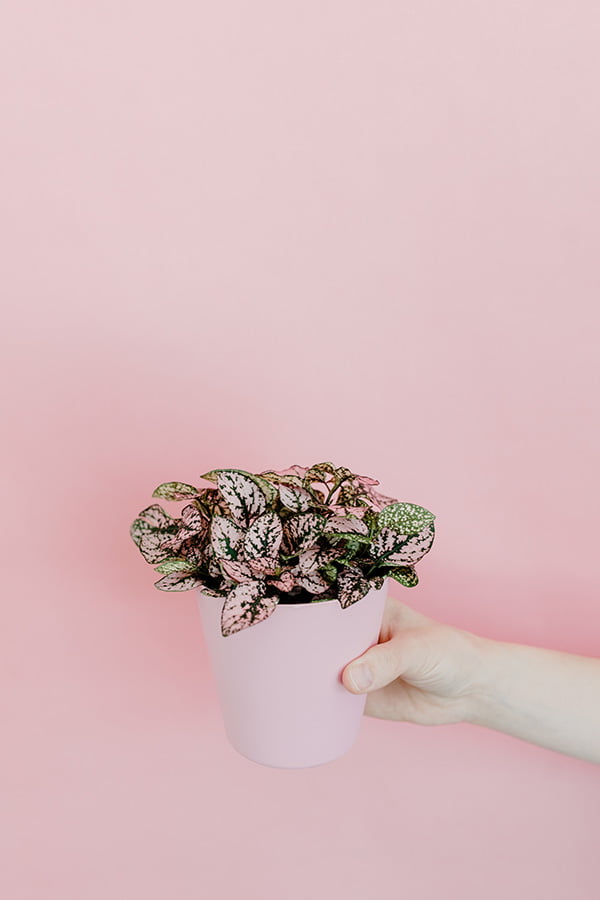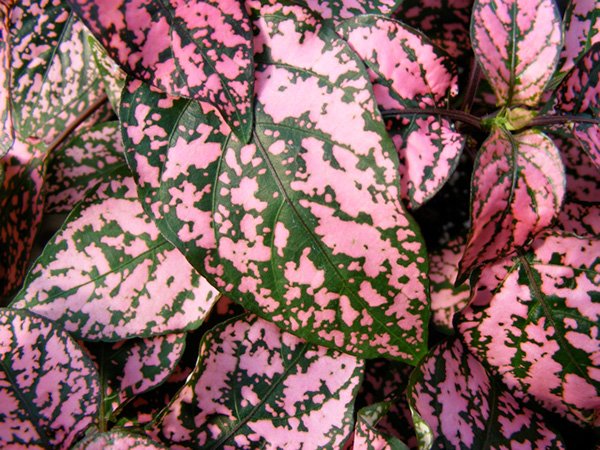The pink polka dot plant is an adorable plant with spectacular leaves! It's a perfect, hardy little houseplant, but you can also grow it outdoors if you live where it's warm! Outside, you will enjoy brightly colored perennial flowers in addition to those stunning pink leaves.
Thinking of adding this cute plant to your plant collection? Below, we'll tell you everything you need to know to help your polka dot plant grow to the best of its ability.
Botanical Name
Common Name
Plant Type
Mature Size
Sun Requirement
Soil Type
Hardiness Zone
Pet Friendly
Hypoestes phyllostachya
Polka dot plant, flamingo plant, freckle face, measles plant, pink dot
Herbaceous, perennial
1-2 ft. tall, 1-2 ft. wide
Bright, indirect light
Nutrient-rich soil that drains easily
10-11
Yes
What Are Pink Polka Dot Plants?
Polka dot plants (Hypoestes phyllostachya) have colorful leaves that vary in hue from green to silver to pink. The pink polka dot plant specifically has leaves with such dense, bright pink variegation that it almost looks like the leaves are pink with green spots rather than the other way around! They are often nicknamed "freckle face plant," "flamingo plant," and "measles plant" because of these pink splotches.
Pink Polka Dot Plant Care Requirements
Light
You'll enjoy more pink on those dark green leaves if you place your pink polka dot plant in a location that receives plenty of bright, indirect light. If you don't provide enough light, the plant will stop producing leaves with as much variegation, as it will prioritize leaves with larger green patches to absorb as much sunlight as possible. Your plant will also grow leggy in its search for more light! On the other hand, if you plant your plant in a location with harsh, direct sunlight, the leaves will scorch and die. A south-facing window will be best, or an east-facing window if your morning sunlight is mild.
Water
The polka dot plant is rather dramatic when the soil gets dry, which is a handy indicator that it's time to give it a drink! They like it best when their soil is kept evenly moist. Don't overwater it, though, or you'll wind up with root rot. Check the top inch of the soil for moisture. Moist soil means that it doesn't need watering yet.

Source: Pexels
Temperature
Polka dot plants are tropical plants native to Madagascar. They thrive in warm temperatures, between 70 and 80 degrees Fahrenheit. You'll often see them sold as annuals in nurseries, and indeed they are in most zones - if you plant outdoors! Treat them as indoor plants, however, and they'll live all year long. Be sure to keep them away from drafts. If your winter is particularly cold, you will likely need to move your pink polka-dot plant away from its window somewhat.
Humidity
Polka dot plants are tropical plants, so they like a 50% humidity level - at a minimum! Some zones might not have a hard time with this during the summer months, but all zones will likely need to boost their indoor humidity levels during the winter. Thankfully, you don't have to turn your home into a greenhouse - there are some tricks for boosting the moisture levels just in the air immediately around your plant.
Grouping: Place humidity-loving plants close together. All plants elevate the humidity in the air right around them, so let the plants help each other!
Bathroom Space: Place your polka dot plant on the windowsill of your bathroom. Put the steam from your showers to good use!
Pebble Tray: Place pebbles in a tray, then fill the tray with water until it comes about halfway up the pebbles. Place your polka dot pot on these pebbles, making sure the pot itself isn't in the water. As the water evaporates, your plant will enjoy the moisture!
Humidifier: Using a humidifier is the fastest way to add humidity to your space.
Soil
The polka dot plant grows in nutrient-rich soil that drains easily. Most standard potting mixes will suffice, and you can make it even better by mixing it with compost (for nutrients) and perlite (for drainage).
Fertilization
While it's not necessary, polka dot plants grow best if they're fed with a diluted liquid fertilizer once a month during the growing season.
Propagation
Polka dot plant propagation is done via stem cuttings. Here's how to propagate polka dot plants:
- Use clean kitchen shears to cut a two-inch length of the plant just below a node. These nodes will turn into roots, so make sure your stem cutting has at least one! The cutting must also have at least one pair of healthy leaves at the top.
- Place the stem cutting directly into a cup of water. Place it in a warm spot with indirect sunlight. You can boost the humidity by placing a plastic bag over the top of the cup and cutting it.
- Replace the water every few days. You'll see roots in a week!
- After the roots of your new pink polka dot plant are an inch long, you can transplant it into a pot with soil.

Source: Flickr
Common Problems
Pink polka dot plant care is pretty straightforward, and these are hardy little plants. But you still might run into problems. Here are some troubleshooting tips.
Watering Issues - Are the leaves turning yellow or even black? You've watered too much and had root rot. Unpot the plant, cut away the dead roots, let the remaining roots dry out, then repot in new soil. Are the leaves wilted and curling at the edges? Give your plant a drink!
Legginess - This is typically a bushy plant, but if it's not getting enough sunlight, it'll lose that attractive mound shape and get scraggly in search of light. You can also encourage it to stay small and compact by planting it in a smaller pot - they don't mind being somewhat root bound.
Pests - The typical houseplant pests (spider mites, mealybugs, aphids) like to hang out with polka dot plants as well. Neem oil will take care of them.
Blooms- These flowering plants will produce 6-inch spike-like pink to purple blooms in late summer or autumn. However, if your pink polka dot plant is flowering, the end of its life cycle is coming. The plant will go dormant if the flower continues to grow. However, removing the flower will give the plant more energy and allow it to thrive for a longer period.
Are Pink Polka Dot Plants Pet Friendly?
Yes, the pink polka dot plant is nontoxic to pets.
